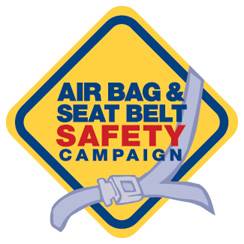Chapter 18: SRS-AIRBAGS
Behind the steering wheel fascia of many cars is a life saving device.
The drivers SRS airbag.
The letters SRS stand for supplementary or secondary restraint system. The airbag’s function is to add to the protection provided by the primary restraint system the seatbelts. Having an airbag might be the difference between a big crash and a fatal crash.
Upon starting an airbag equipped car, an SRS warning lamp should illuminate on the instrument panel. It signals that the airbag system is self-checking itself. Once the check has been performed the SRS warning lamp will go out this usually takes about 7 seconds.
If this does not occur and the lamp flashes or fails to come on when starting the car, have the system checked immediately by your nearest car dealer.
The SRS airbag does not replace the need to wear a seatbelt. They are designed to work together to maximize safety. The seatbelts help keep the driver correctly positioned for airbag inflation and slows the movement of the occupant forward allowing the airbag to inflate in front of occupants and not into occupants.
Airbags provide direct protection to a drivers head and chest by absorbing energy (cushioning) during contact with the vehicles interior.
Most airbags inflate by the ignition of a sodium azide fuse which burns (explodes) to rapidly produce nitrogen gas. Airbags are triggered around 50 milliseconds after a crash (deemed severe enough to warrant their ignition). They inflate fully in only a few more milliseconds. The speed of inflation being over 200 km/hr.
On deployment the explosion will create a loud noise and release some smoke and powder. The airbag will rapidly deflate as the gas escapes through vents. So your vision will not be obscured.
It should be noted that the airbag works once and any subsequent impacts made in the accident will not have airbag protection.
Depending on the design of the car and airbag system, in some collisions the airbag might not work, due to the angle of collision or other factors that the sensor decided did not warrant inflation.
Airbags inflate very fast and with great force as such before driving an airbag equipped vehicle adjust the drivers seat as shown in an earlier segments of this program.
Sitting too close when an airbag deploys can cause injury. (demonstrate) Never lean forward in the seat, keep your entire back against the seat, including shoulders. You may need to incline the seat more.
Before airbags cars needed soft interiors!
Steering techniques and hand positioning are critical in an airbag equipped vehicle. The airbag systems assumes your hands are at 3 o’clock and 9 o’clock on the wheel. With your hands higher on the wheel as many novice drivers are taught, the airbag on inflation can break wrists or arms and send your fists back towards you head at over 200 km/hr, delivering a knock-out blow.
There is a wide variety of trigger speeds for cars with airbags, generally though due to high seatbelt wearing rates in Australia, our airbags have been calibrated for higher speed impacts above which the seatbelt will not stop head impact with the front of the cabin.
Wearing a seatbelt correctly and being a correct distance back from the dashboard will provide protection up to about 24 km/hr of impact speed. Above this additional injuries result from contact with internal surfaces. The airbag is designed to reduce these injuries and as such triggers in crashes over 24km/hr. As such airbags in Australian vehicles are not designed to trigger in low speeds collisions when they are not required.
Additional SRS Airbag information and warnings are usually provided in both the vehicle handbook and as a sticker on the drivers and if necessary passengers sun-visor.
I hope you never see the airbag work in real life. But it provides added peace of mind driving an airbag equipped vehicle.
Thankfully the fitment rate for airbags in Australian cars has risen to 85%.
Whilst ABS brakes might avoid having the crash, not all crashes are avoidable, as such buying a car with the added safety of an airbag is worth considering.
(Written by Joel Neilsen, Managing Director, Safe Drive Training)



